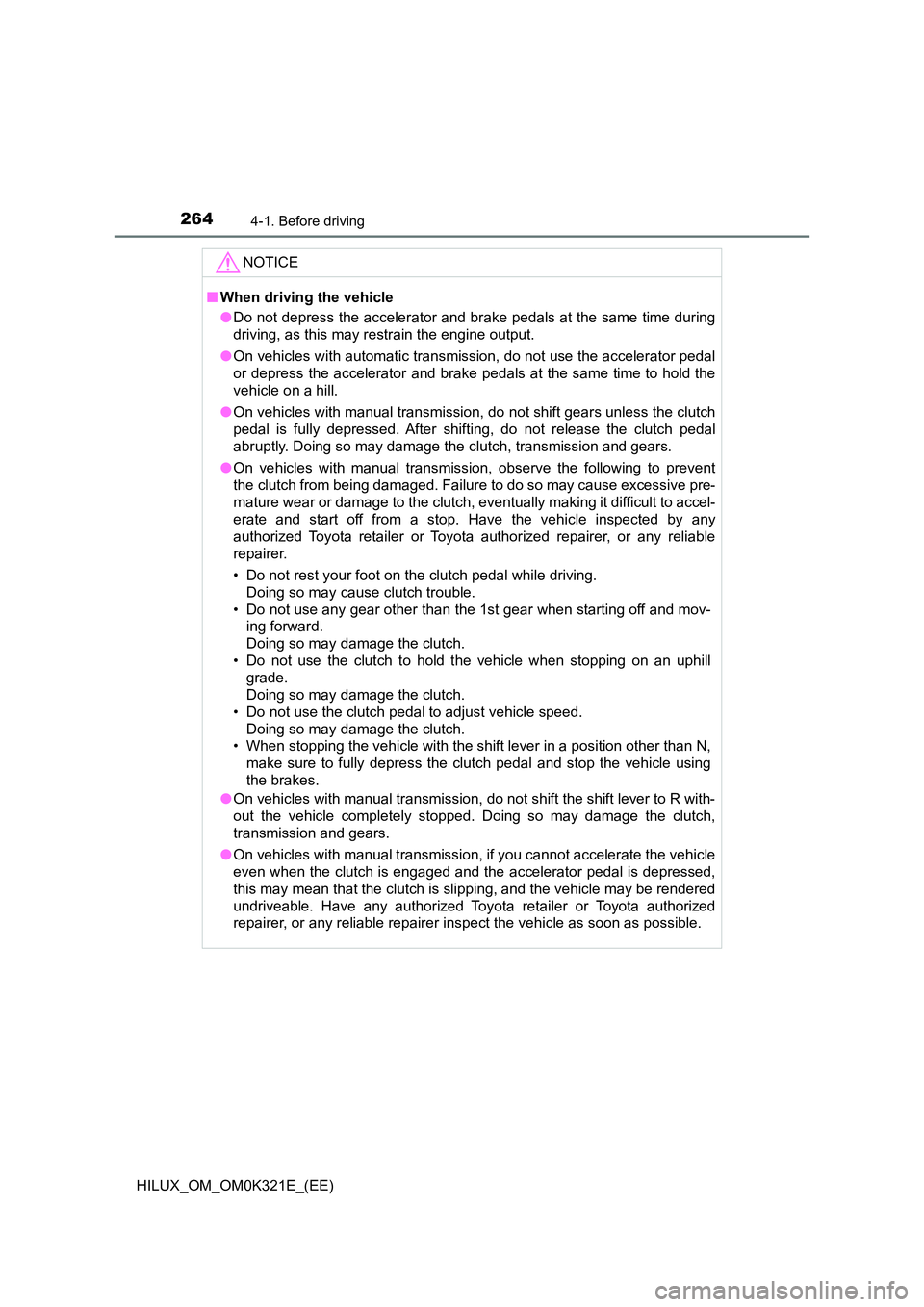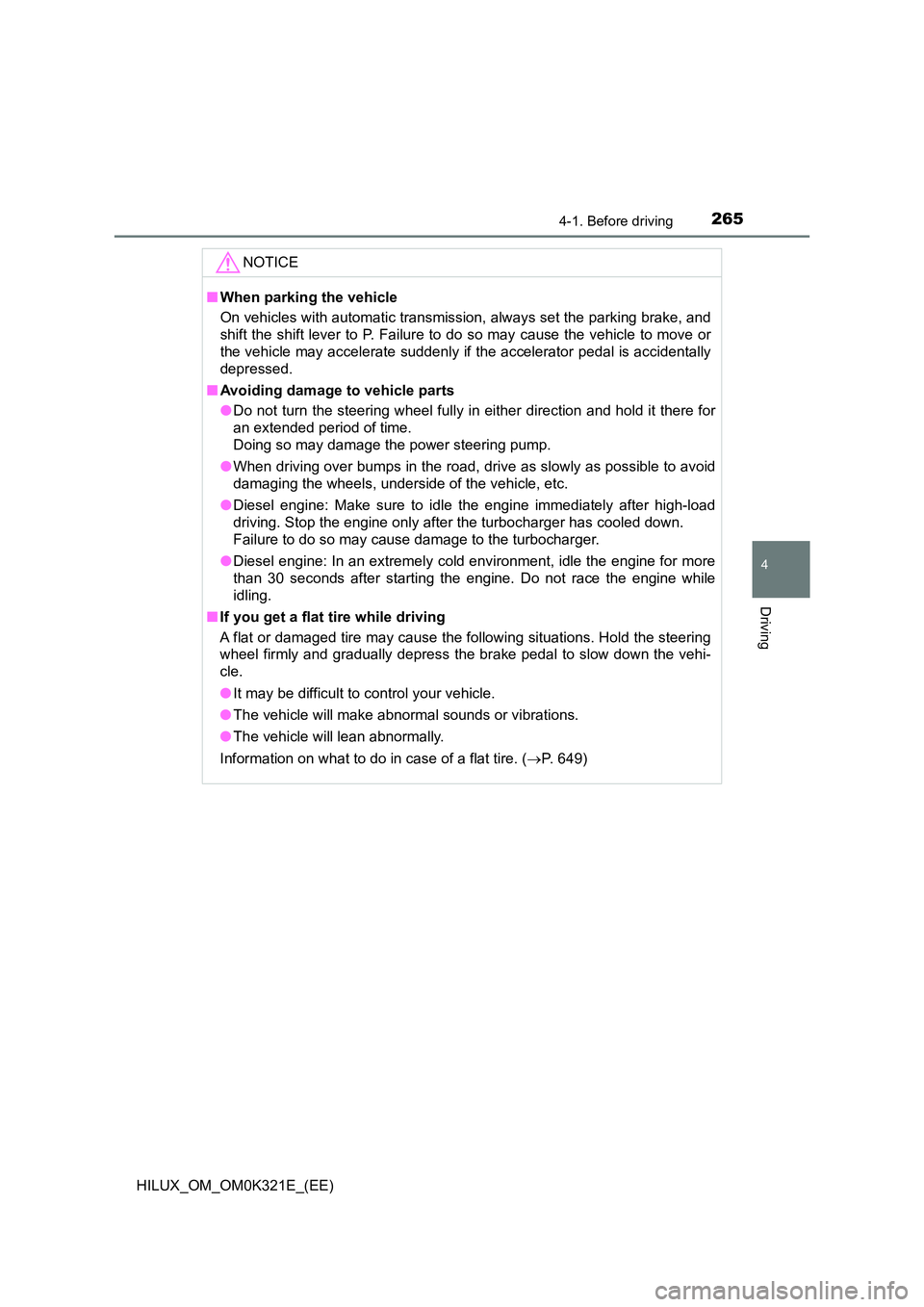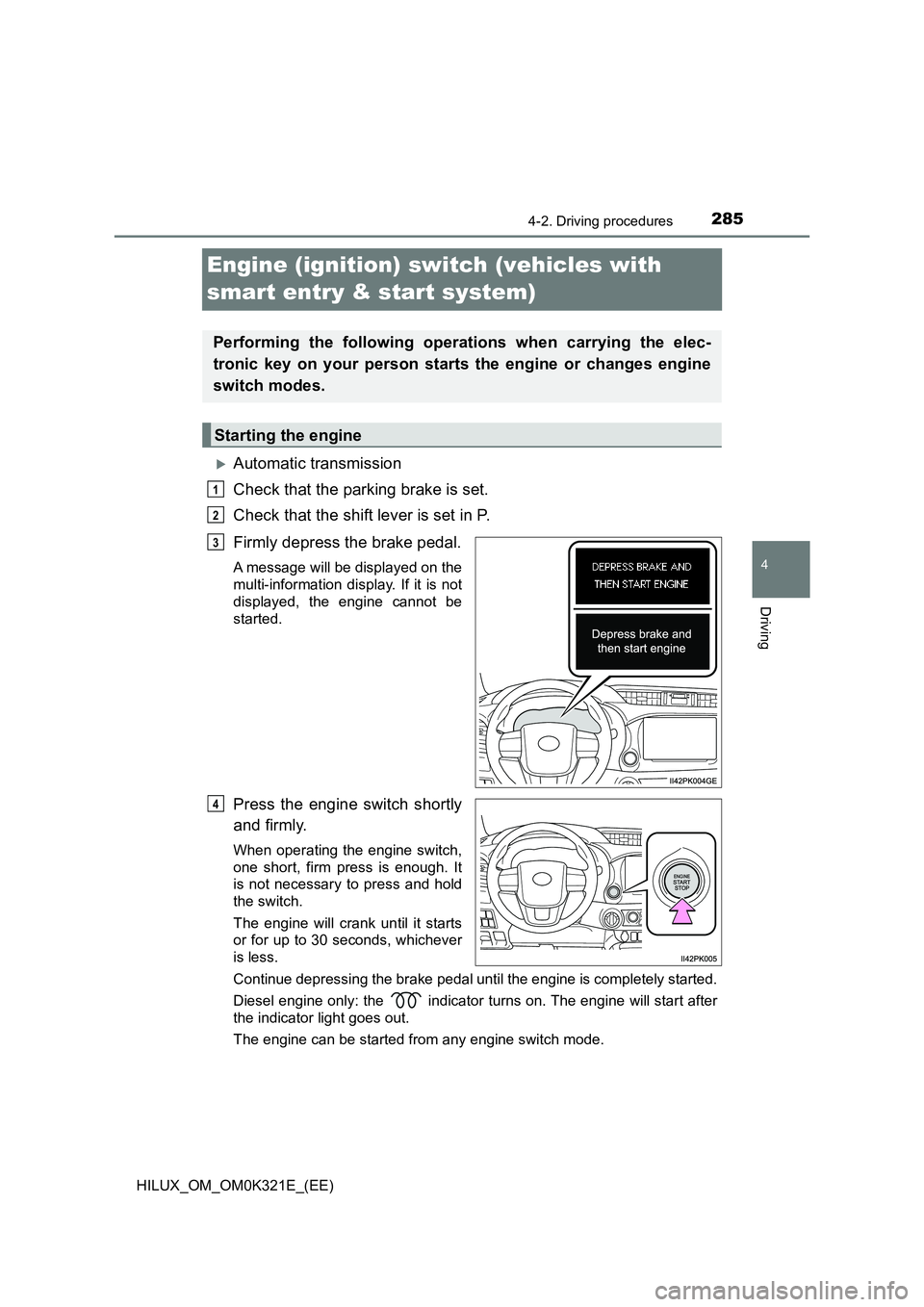engine TOYOTA HILUX 2020 (in English) Repair Manual
[x] Cancel search | Manufacturer: TOYOTA, Model Year: 2020, Model line: HILUX, Model: TOYOTA HILUX 2020Pages: 744, PDF Size: 108.13 MB
Page 264 of 744

2644-1. Before driving
HILUX_OM_OM0K321E_(EE)
NOTICE
■When driving the vehicle
● Do not depress the accelerator and brake pedals at the same time during
driving, as this may restrain the engine output.
● On vehicles with automatic transmission, do not use the accelerator pedal
or depress the accelerator and brake pedals at the same time to hold the
vehicle on a hill.
● On vehicles with manual transmission, do not shift gears unless the clutch
pedal is fully depressed. After shifting, do not release the clutch pedal
abruptly. Doing so may damage the clutch, transmission and gears.
● On vehicles with manual transmission, observe the following to prevent
the clutch from being damaged. Failure to do so may cause excessive pre-
mature wear or damage to the clutch, eventually making it difficult to accel-
erate and start off from a stop. Have the vehicle inspected by any
authorized Toyota retailer or Toyota authorized repairer, or any reliable
repairer.
• Do not rest your foot on the clutch pedal while driving.
Doing so may cause clutch trouble.
• Do not use any gear other than the 1st gear when starting off and mov-
ing forward.
Doing so may damage the clutch.
• Do not use the clutch to hold the vehicle when stopping on an uphill
grade.
Doing so may damage the clutch.
• Do not use the clutch pedal to adjust vehicle speed.
Doing so may damage the clutch.
• When stopping the vehicle with the shift lever in a position other than N,
make sure to fully depress the clutch pedal and stop the vehicle using
the brakes.
● On vehicles with manual transmission, do not shift the shift lever to R with-
out the vehicle completely stopped. Doing so may damage the clutch,
transmission and gears.
● On vehicles with manual transmission, if you cannot accelerate the vehicle
even when the clutch is engaged and the accelerator pedal is depressed,
this may mean that the clutch is slipping, and the vehicle may be rendered
undriveable. Have any authorized Toyota retailer or Toyota authorized
repairer, or any reliable repairer inspect the vehicle as soon as possible.
Page 265 of 744

2654-1. Before driving
4
Driving
HILUX_OM_OM0K321E_(EE)
NOTICE
■When parking the vehicle
On vehicles with automatic transmission, always set the parking brake, and
shift the shift lever to P. Failure to do so may cause the vehicle to move or
the vehicle may accelerate suddenly if the accelerator pedal is accidentally
depressed.
■ Avoiding damage to vehicle parts
● Do not turn the steering wheel fully in either direction and hold it there for
an extended period of time.
Doing so may damage the power steering pump.
● When driving over bumps in the road, drive as slowly as possible to avoid
damaging the wheels, underside of the vehicle, etc.
● Diesel engine: Make sure to idle the engine immediately after high-load
driving. Stop the engine only after the turbocharger has cooled down.
Failure to do so may cause damage to the turbocharger.
● Diesel engine: In an extremely cold environment, idle the engine for more
than 30 seconds after starting the engine. Do not race the engine while
idling.
■ If you get a flat tire while driving
A flat or damaged tire may cause the following situations. Hold the steering
wheel firmly and gradually depress the brake pedal to slow down the vehi-
cle.
● It may be difficult to control your vehicle.
● The vehicle will make abnormal sounds or vibrations.
● The vehicle will lean abnormally.
Information on what to do in case of a flat tire. ( P. 649)
Page 266 of 744

2664-1. Before driving
HILUX_OM_OM0K321E_(EE)
NOTICE
■When encountering flooded roads
Do not drive on a road that has flooded after heavy rain etc. Doing so may
cause the following serious damage to the vehicle:
● Engine stalling
● Short in electrical components
● Engine damage caused by water immersion
In the event that you drive on a flooded road and the vehicle is flooded, or
on a sandy road, be sure to have any authorized Toyota retailer or Toyota
authorized repairer, or any reliable repairer check the following:
● Brake function
● Changes in quantity and quality of oil and fluid used for the engine, trans-
mission, transfer (4WD models), clutch, differential, etc.
● Lubricant condition for the propeller shaft, bearings and suspension joints
(where possible), and the function of all joints, bearings, etc.
■ Off-road driving (vehicles with type A wheel ornaments [P. 656])
When driving on muddy roads, rocky terrain or sand, or crossing rivers,
remove the wheel ornaments. Driving with the wheel ornaments installed
may cause the wheel ornaments to be damaged or even fall off.
After off-road driving with the wheel ornaments removed, remove dirt or for-
eign objects from the wheel before reinstalling the wheel ornaments.
Page 272 of 744

2724-1. Before driving
HILUX_OM_OM0K321E_(EE)
■Important points regarding stability
Vehicle movement resulting from uneven road surfaces and strong
crosswinds will affect handling. The vehicle may also be rocked by
passing buses or large trucks. Frequently check behind when mov-
ing alongside such vehicles. As soon as such vehicle movement
occurs, immediately start to decelerate smoothly by slowly applying
the brakes. Always steer the vehicle straight ahead while braking.
■Passing other vehicles
Consider the total combined length of your vehicle and trailer and
ensure that the vehicle-to-vehicle distance is sufficient before exe-
cuting lane changes.
■Transmission information
Vehicles with manual transmission: To maintain engine braking effi-
ciency when using engine braking, do not use 5th gear and 6th
gear.
Vehicles with automatic transmission: To maintain engine braking
efficiency when using engine braking, do not use the transmission
in D. Transmission shift range position must be in 4 or lower, in S
mode.
■If the engine overheats
Towing a loaded trailer up a long, steep incline in temperatures
exceeding 30 C (85F) may result in the engine overheating. If the
engine coolant temperature gauge indicates that the engine is over-
heating, turn the air conditioning off immediately, leave the road and
stop the vehicle in a safe place. ( P. 678)
■When parking the vehicle
Always place wheel chocks under the wheels of both the vehicle
and trailer. Firmly set the parking brake and shift the shift lever to P
for automatic transmissions, and 1 or R for manual transmissions.
Page 275 of 744

2754-1. Before driving
4
Driving
HILUX_OM_OM0K321E_(EE)
■Information tag (manufacturer’s label) (if equipped)
Gross vehicle mass
The combined weight of the driver, passengers, luggage, towing
hitch, total curb mass and drawbar load should not exceed the
gross vehicle mass by more than 100 kg (220.5 lb.). Exceeding
this weight is dangerous.
Maximum permissible rear axle capacity
The weight borne by the rear axle should not exceed the maxi-
mum permissible rear axle capacity by 15% or more. Exceeding
this weight is dangerous.
The values for towing capacity were derived from testing con-
ducted at sea level. Take note that engine output and towing
capacity will be reduced at high altitudes.
1
2
Ty pe AType B
WARNING
■ When the gross vehicle mass or maximum permissible axle capacity is
exceeded
Failing to observe this precaution may lead to an accident causing death or
serious injury.
● Add an additional 20.0 kPa (0.2 kgf/cm2 or bar, 3 psi) to the recommended
tire inflation pressure value. ( P. 711)
● Do not exceed the established speed limit for towing a trailer in built-up
areas or 100 km/h (62 mph), whichever is lower.
Page 279 of 744

2794-1. Before driving
4
Driving
HILUX_OM_OM0K321E_(EE)
■Information tag (manufacturer’s label)
Gross vehicle mass
The combined weight of the driver, passengers, luggage, towing
hitch, total curb mass and drawbar load should not exceed the
gross vehicle mass by more than 100 kg (220.5 lb.). Exceeding
this weight is dangerous.
Maximum permissible rear axle capacity
The weight borne by the rear axle should not exceed the maxi-
mum permissible rear axle capacity by 15 % or more. Exceeding
this weight is dangerous.
The values for towing capacity were derived from testing con-
ducted at sea level. Take note that engine output and towing
capacity will be reduced at high altitudes.
1
2
Ty pe AType B
WARNING
■ When the total trailer weight exceeds 3200kg (7055 lb.)
Do not exceed the legal speed limit for towing a trailer or 90 km/h (56 mph),
whichever is lower.
Failing to observe this precaution may lead to an accident causing death or
serious injury.
■ When the gross vehicle mass or maximum permissible axle capacity is
exceeded
Failing to observe this precaution may lead to an accident causing death or
serious injury.
● Add an additional 20.0 kPa (0.2 kgf/cm2 or bar, 3 psi) to the recommended
tire inflation pressure value. ( P. 711)
● Do not exceed the established speed limit for towing a trailer in built-up
areas or 100 km/h (62 mph), whichever is lower.
Page 282 of 744

2824-2. Driving procedures
HILUX_OM_OM0K321E_(EE)
Engine (ignition) switch (vehicles without
smart entry & start system)
Automatic transmission (gasoline engine)
Check that the parking brake is set.
Check that the shift lever is set in P.
Firmly depress the brake pedal.
Turn the engine switch to the “START” position to start the engine.
Automatic transmission (diesel engine)
Check that the parking brake is set.
Check that the shift lever is set in P.
Firmly depress the brake pedal.
Turn the engine switch to the “ON” position.
The indicator turns on.
After the indicator light goes out, turn the engine switch to the
“START” position to start the engine.
Manual transmission (gasoline engine)
Check that the parking brake is set.
Check that the shift lever is set in N.
Firmly depress the clutch pedal.
Turn the engine switch to the “START” position to start the engine.
Manual transmission (diesel engine)
Check that the parking brake is set.
Check that the shift lever is set in N.
Firmly depress the clutch pedal.
Turn the engine switch to the “ON” position.
The indicator turns on.
After the indicator light goes out, turn the engine switch to the
“START” position to start the engine.
Starting the engine
1
2
3
4
1
2
3
4
5
1
2
3
4
1
2
3
4
5
Page 283 of 744

2834-2. Driving procedures
4
Driving
HILUX_OM_OM0K321E_(EE)
“LOCK”
The steering wheel is locked and
the key can be removed. (Vehicles
with automatic transmission: The
key can be removed only when the
shift lever is in P.)
“ACC”
Some electrical components such
as the audio system can be used.
“ON”
All electrical components can be used.
“START”
For starting the engine.
■ Turning the key from “ACC” to “LOCK”
Shift the shift lever to P (automatic transmission) or N (manual transmis-
sion). ( P. 293, 300)
■ If the engine does not start (vehicles with engine immobilizer system)
The engine immobilizer system may not have been deactivated. ( P. 105)
Contact any authorized Toyota retailer or Toyota authorized repairer, or any
reliable repairer.
Changing the engine switch positions
1
2
Push in the key and turn it to the
“LOCK” position.
3
4
1
2
Page 284 of 744

2844-2. Driving procedures
HILUX_OM_OM0K321E_(EE)
■ When the steering lock cannot be released
■ Key reminder function
A buzzer sounds if the driver’s door is opened while the engine switch is in
the “LOCK” or “ACC” position to remind you to remove the key.
When starting the engine, the engine
switch may seem stuck in the “LOCK”
position. To free it, turn the key while turn-
ing the steering wheel slightly left and
right.
WARNING
■ When starting the engine
Always start the engine while sitting in the driver’s seat. Do not depress the
accelerator pedal while starting the engine under any circumstances.
Doing so may cause an accident resulting in death or serious injury.
■ Caution when driving
Do not turn the engine switch to the “LOCK” position while driving.
If in an emergency, you must turn the engine off while the vehicle is moving,
turn the engine switch only to the “ACC” position to stop the engine. An
accident may result if the engine is stopped while driving. ( P. 625)
NOTICE
■To prevent battery discharge
Do not leave the engine switch in the “ACC” or “ON” position for long peri-
ods of time without the engine running.
■ When starting the engine
● Do not crank the engine for more than 30 seconds at a time. This may
overheat the starter and wiring system.
● Do not race a cold engine.
● If the engine becomes difficult to start or stalls frequently, have your vehi-
cle checked by any authorized Toyota retailer or Toyota authorized
repairer, or any reliable repairer immediately.
Page 285 of 744

285
4
4-2. Driving procedures
Driving
HILUX_OM_OM0K321E_(EE)
Engine (ignition) switch (vehicles with
smart entry & start system)
Automatic transmission
Check that the parking brake is set.
Check that the shift lever is set in P.
Firmly depress the brake pedal.
A message will be displayed on the
multi-information display. If it is not
displayed, the engine cannot be
started.
Press the engine switch shortly
and firmly.
When operating the engine switch,
one short, firm press is enough. It
is not necessary to press and hold
the switch.
The engine will crank until it starts
or for up to 30 seconds, whichever
is less.
Continue depressing the brake pedal until the engine is completely started.
Diesel engine only: the indicator turns on. The engine will start after
the indicator light goes out.
The engine can be started from any engine switch mode.
Performing the following operations when carrying the elec-
tronic key on your person starts the engine or changes engine
switch modes.
Starting the engine
1
2
3
4